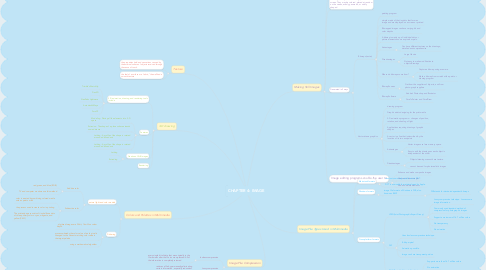
1. Texture
1.1. the properties held and sensations caused by the external surface of objects received through the sense of touch.
1.2. the feel of a surface or a fabric; "the wall had a smooth texture
2. 3-D drawing
2.1. 3-D animation, drawing, and rendering tools include
2.1.1. Trimble’s SketchUp
2.1.2. Daz3D
2.1.3. NewTek′s Lightwave
2.1.4. Autodesk’s Maya
2.1.5. Form*Z
2.2. Features
2.2.1. Modeling - Placing all the elements into 3-D space
2.2.2. Extrusion - The shape of a plane surface extends some distance.
2.2.3. Lathing - A profile of the shape is rotated around a defined axis
2.2.4. Lathing - A profile of the shape is rotated around a defined axis
2.3. Creation of Still Images
2.3.1. Lathing
2.3.2. Extruding
2.4. Rendering
3. Colors and Palettes in Multimedia
3.1. natural light and color models
3.1.1. Additive color
3.1.1.1. red, green, and blue (RGB).
3.1.1.2. TV and computer monitors use this method
3.1.2. Subtractive color
3.1.2.1. color is created by combining colored media such as paints or ink
3.1.2.2. the process used to create color in printing.
3.1.2.3. The printed page consists of tiny halftone dots of three primary colors: cyan, magenta, and yellow (CMY).
3.2. Dithering
3.2.1. , digitised images are 24 bit, 16 million colour depth.
3.2.2. process whereby the color value of each pixel is changed to the closest matching color value in the target palette
3.2.3. using a mathematical algorithm
4. Image File Compression
4.1. lossless compression
4.1.1. every single bit of data that was originally in the file remains after the file is uncompressed. All of the information is completely restored
4.2. Lossy compression
4.2.1. reduces a file by permanently eliminating certain information, especially redundant information
5. Making Still Images
5.1. Still images may be the most important element of a multimedia project
5.2. Still images may be small or large, or even full screen. They may be colored, placed at random on the screen, evenly geometric, or oddly shaped.
5.3. Generated in 2 ways
5.3.1. Bitmaps (raster)
5.3.1.1. painting program
5.3.1.2. simple matrix of the tiny dots that form an image and are displayed on a screen or printed
5.3.1.3. Bitmapped images can have varying bit and color depths
5.3.1.4. A bitmap is made up of individual dots or picture elements known as pixels or pels.
5.3.1.5. Advantages
5.3.1.5.1. Can have different textures on the drawings; detailed and comprehensive
5.3.1.6. Disadvantages
5.3.1.6.1. Large file size
5.3.1.6.2. Not easy to make modification to objects/drawings
5.3.1.7. Where do bitmaps come from?
5.3.1.7.1. Capture a bitmap using a camera.
5.3.1.7.2. Make a bitmap from scratch with a paint or drawing program
5.3.1.8. Bitmap Sources
5.3.1.8.1. Get from the suppliers of clip arts, and from photo-graph suppliers
5.3.1.9. Bitmap Software
5.3.1.9.1. Adobe’s Photoshop and Illustrator
5.3.1.9.2. Corel’s Painter and CorelDraw
5.3.2. Vector-drawn graphics
5.3.2.1. drawing program
5.3.2.2. Graphic artists designing for the print media
5.3.2.3. 3-D animation programs – changes of position, rotation, and shading of light
5.3.2.4. Applications requiring drawing of graphic shapes
5.3.2.5. A vector is a line that is described by the location of its two endpoints
5.3.2.6. Advantages
5.3.2.6.1. Vector images use less memory space.
5.3.2.6.2. Easy to edit the drawings as each object is independent of the other
5.3.2.7. Disadvantages
5.3.2.7.1. Objects/drawings cannot have texture.
5.3.2.7.2. cannot be used for photorealistic images
5.4. Image editing programs enable the user to:
5.4.1. Enhance and make composite images
5.4.2. Alter and distort images
5.4.3. Add and delete elements
6. Image File Types Used in Multimedia
6.1. Macintosh formats
6.1.1. the most commonly used format is PICT.
6.1.2. PICT is a versatile format developed by Apple.
6.2. Windows formats
6.2.1. image file format on Windows is DIB, also known as BMP.
6.2.1.1. DIB stands for device-independent bitmaps.
6.3. Cross-platform formats
6.3.1. JPEG(Joint Photographic Expert Group )
6.3.1.1. Lossy compression technique: Losses some image information.
6.3.1.2. Commonly used standard method of compression for photographic images
6.3.1.3. Support a maximum of 16.7 million colors
6.3.1.4. No transparency
6.3.1.5. No animation
6.3.2. GIF
6.3.2.1. Uses lossless compression technique.
6.3.2.2. 8-bit per pixel
6.3.2.3. Animation possible.
6.3.2.4. Image can have transparent portion
6.3.3. PNG (Portable Network Graphic )
6.3.3.1. Supports more than 16.7 million colors
6.3.3.2. No animation
6.3.3.3. Image can have transparent portion
6.3.3.4. Use Lossless Compression Technique

